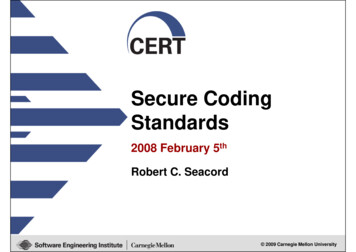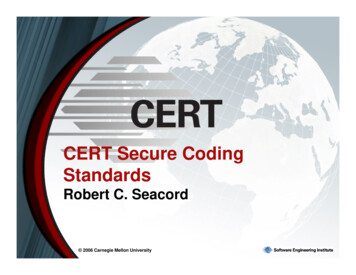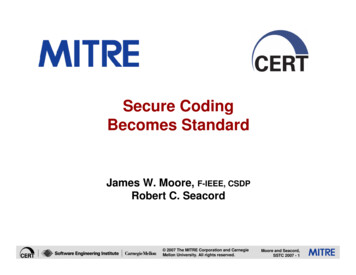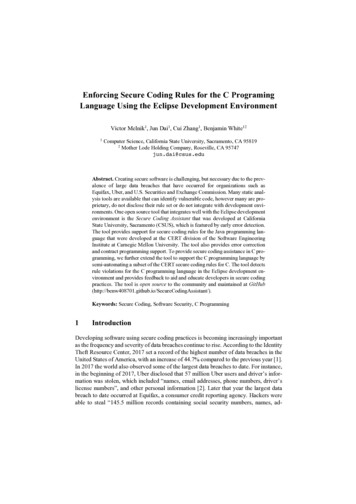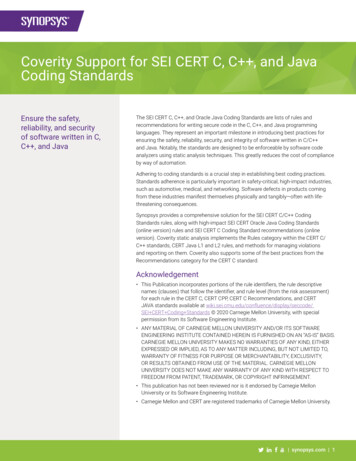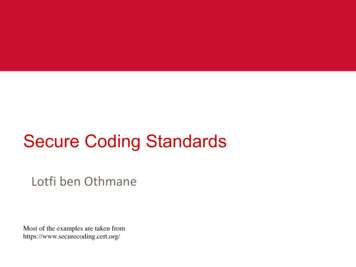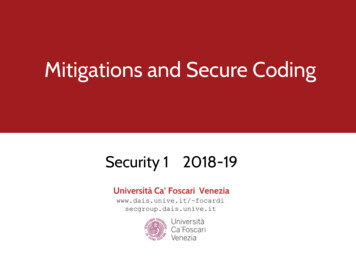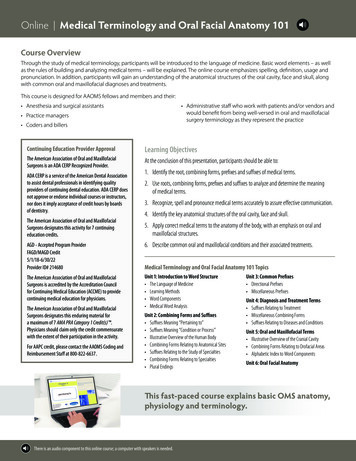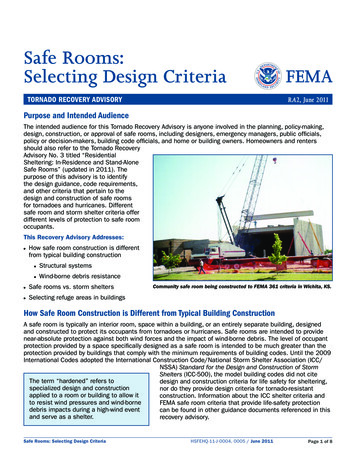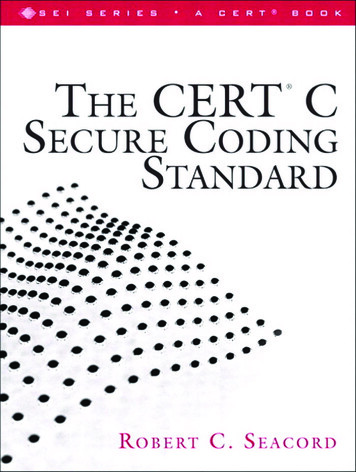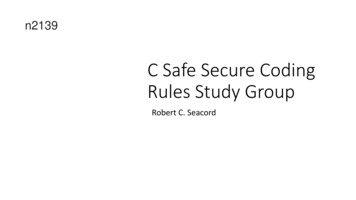
Transcription
n2139C Safe Secure CodingRules Study GroupRobert C. Seacord
AgendaRequirements of the safety and security marketsMISRA C and CERT CHistory of ISO/IEC TS 17961Combined safety and security International Standard
The C programming LanguageSpirit of C:a. Trust the programmer.b. Do not prevent the programmer from doing what needs to be done.c. Keep the language small and simple.d. Provide only one way to do an operation.e. Make it fast, even if it is not guaranteed to be portable.The C programming language serves a variety of markets including safety-criticalsystems and secure systems.While advantageous for system level programming, facets (a) and (b) can beproblematic for safety and security.Consequently, the C11 revision added a new facet:f. Make support for safety and security demonstrable.
Coding StandardsCoding standard exist to service the safety and security marketsperforming C language development.The safety-critical systems market is primarily served by The MotorIndustry Software Reliability Association (MISRA), a UK-basedcollaboration between manufactures component suppliers engineering consultanciesThe security market is primarily addressed by The CERT C CodingStandard published by Addison-Wesley.
Automotive and Aerospace IndustriesThe automotive and aerospace industries are major consumers of codingstandards for safety-critical systems.At many organizations, safety-critical code is written in C.Extensive tool support for this language including strong source code analyzers logic model extractors metrics tools debuggers test support tools choice of mature, stable compilers.
Safety StandardsThe safety community constrains development to a subset of the Clanguage that is considered less prone to error.These language subsets are influenced by the IEC 61508 series ofinternational standards for electrical, electronic, and programmableelectronic safety-related systems.
ISO 26262 Road vehicles — Functional safetyISO 26262 is an adaptation of IEC 61508 for automotive electric/electronic systems that has beenwidely adopted by the major automotive manufacturers.Focuses on the electronic systems installed in series-production passenger cars.Introduces four Automotive Safety Integrity Levels (ASIL A – D) ASIL D is the most stringent level. allows different methods to be applied depending upon the ASIL of the system at a functionallevel.Part 6 specifically addresses software development, placing requirements on the initiation of software development software architectural design and software unit design implementation7
Design Principles for Software Unit Designand ImplementationM3CM MISRA C:2012MethodsASILThe ToolA B C D Applicable to M3CM rule 15.5 Applicable to M3CM rule 21.3 Applicable to M3CM rule 9.11c.One entry and one exit point insubprograms and functionsNo dynamic objects or variables, or elseonline test during their creationInitialization of variables1d.No multiple use of variable names Applicable to M3CM rules 5.3, 5.6-5.91e. Applicable to M3CM rules 8.7, 8.91f.1g.Avoid global variables or else justifytheir usageLimited use of pointersNo implicit type conversionso Applicable to M3CM rules 8.13, 18.1 – 18.5Applicable to M3CM rules 10.1-10.8, 11.6-11.91h.No hidden data flow or control flow Applicable to M3CM rules 2.1, 5.3,13.2, 18.1-18.5, 20.1,20.7, 20.10, directive 4.91i.No unconditional jumps Applicable to M3CM rule 15.11j.No recursions Applicable to M3CM rules 17.21a.1b.8
Aviation StandardsDO-178C Software Considerations in Airborne Systems and EquipmentCertification’ standard published by the Radio Technical Commissionfor Aeronautics (RTCA) is used for commercial software-basedaerospace systems.
Security StandardsThe security community serves a broader marketSecurity is more often an attribute of applications and systems whoseprimary purpose is to deliver functionality and for which security istypically one of several system qualities that may be traded-of againstother qualities such as performance and usability.These applications frequently make use of the whole language,including dynamic memory, which makes subsetting the language toocostly to consider.
AgendaRequirements of the safety and security marketsMISRA C and CERT CHistory of ISO/IEC TS 17961Combined safety and security International Standard
MISRAThe MISRA C Guidelines define a subset of the C language that reduces the opportunities formistakes.The first edition of MISRA C, ‘Guidelines for the use of the C language in vehicle based software’ waspublished in 1998 to provide a restricted subset of C to meet the requirements of IEC 61508 SafetyIntegrity Level 2 and above.Since that time, MISRA C has been adopted by a wide variety of industries and applicationsincluding the rail, aerospace, military, and medical sectors.The second edition, known as MISRA C:2004 is titled ‘Guidelines for the use of the C language incritical systems’.The first two editions of MISRA were based on C90.MISRA C:2012 extends support for C99 while maintaining guidelines for C90.
MISRA ProvenanceMISRA started in the early 1990s as a project in the UK government’s SafeITprogramme.The MISRA project was conceived to develop guidelines for the creation ofembedded software in road vehicle electronic systems.In November 1994, development guidelines for vehicle-based software werepublished.Once the official funding had finished, the MISRA members continued towork together on an informal basis.Today, the MISRA Consortium is coordinated by a steering committee of themember companies. The project management has been provided by MIRALimited, a for-profit organization.
MISRA C ReleasesMISRA C:2012MISRA C:2012 Addendum 1MISRA-C:2004 v MISRA C:2012MISRA C:2012 Addendum 2Coverage against “C Secure”MISRA C:2012 Amendment 1Additional security guidelines
MISRA C Work in ProgressWork In Progress – To be issued “soon” MISRA C:2012 Tech. Corr. 1 MISRA C:2012 Addendum 2, 2nd Ed Coverage against “C-Secure” MISRA C:2012 Addendum 3Coverage against “CERT-C” Exemplar SuiteTo roll-up as a new issued MISRA C document in due course.
MISRA CWork In Progress Update for C11 revisions to “Core” functionality Review of Standard Library rules and exclusions Enhancements to Exemplar SuiteNew Work Items New C11 Functionality
MISRA Flowchart
CERT C Coding StandardThe CERT C Secure Coding Standard was developed at the request of,and in concert with, the C Standards Committee.The 1st edition (a/ka/ CERT C:2008) was published in 14 October 2008.The 2nd edition of The CERT C Coding Standard (a/k/a CERT C:2014)was published in 2014. updated to support C11 aligned with ISO/IEC TS 17961
Hosted v Freestanding ImplementationsThe C Standard supports two forms of conforming implementations hosted freestanding In a freestanding environment, a C program execution may take place without thebenefit of an operating system, as is common in low-end embedded systems.MISRA C no library-specific restrictions on the subset of headers required in freestandingimplementations major restrictions and prohibitions on many of the remaining standard headers inhosted implementations.CERT C fully supports both hosted and freestanding environments19
Key Features of Coding StandardsCodingStandardMISRAC:2004MISRAC:2012CERT ationa Wholel Standard LanguageNoNoC99NoYesNoNoC99YesNoNoYesCERT C:2014 C11YesNoNoYesISO/IECTS 17961YesNoYesYesC StandardC11
Standard Development OrganizationsISO/IEC JTC1/SC22/WG14 is the international standardization workinggroup for the programming language C.INCITS Technical Committee PL22.11 is the U.S. organization responsible for the C programming languagestandard. U.S. TAG to ISO/IEC JTC 1 SC22/WG14 and providesrecommendations on U.S. positions to the JTC 1 TAG.
AgendaRequirements of the safety and security marketsMISRA C and CERT CHistory of ISO/IEC TS 17961Combined safety and security International Standard
HistoryThe idea of C secure coding guidelines arose during the discussion ofthe managed strings proposal at the Berlin meeting of the ISO/IEC JTC1/SC 22/WG14 for standardization of the C language in March 2006.The closest existing product at the time, MISRA C, was generally viewedby the committee as inadequate because, among other reasons, itprecluded all the language features that had been introduced byISO/IEC 9899:1999.
C Secure Coding Guidelines SGWG14 established a study group to study the problem of producinganalyzable secure coding guidelines for the C language. First meeting was held on October 27, 2009. Participants included analyzer vendors, security experts, languageexperts, and consumers. New work item approved March 2012; study group concluded.
ISO/IEC TS 17961Applies to analyzers, includingstatic analysis tools and Clanguage compilers that wishto diagnose insecure codebeyond the requirements of the language standard.Enumerates secure coding rules and requires analysis engines todiagnose violations of these rules as a matter of conformance to thisspecification.These rules may be extended in an implementation-dependentmanner, which provides a minimum coverage guarantee to customersof any and all conforming static analysis implementations.
Secure Coding Validation SuiteA set of tests to validate the rules defined in TS 17961, these tests arebased on the examples in this technical tributed with a BSD-style license.
AgendaRequirements of the safety and security marketsMISRA C and CERT CHistory of ISO/IEC TS 17961Combined safety and security International Standard
Safety/Security Rules Study GroupFollowing the Fall 2016 WG14 Pittsburgh a Safety/Security Rules Study Groupwas created to:1. Study the problem of adding coverage for safety-critical andsafety/security-critical issues into the existing C Secure Coding Rules TS.2. Study the problem of addressing safety and security issues related toparts of the C standard not currently covered by the TS, such asconcurrency.3. Propose updates to TS 17961 based on these studies and based onexperience gained with the TS since its publication.4. Recommend to WG 14 a course of action for the resulting document,such as creating a new edition of the TS, or making it into anInternational Standard.
Study Group Members 1 of 3 Roberto BagnaraAaron BallmanAndrew BanksJim MacArthurKayvan MemarianClive PygottRobert C. SeacordPeter SewellBarnaby StewartUniversity of Parma / BUGSENGGrammaTechFrazer Nash ResearchCodethinkUniversity of CambridgeLDRANCC Group / CMUUniversity of CambridgeNCC Group Murali SomanchyQualcomm Daniel Godas-LopezQualcomm
Study Group Members Elisa Heymann PignoloAdele CarterIan HawkesKayvan MemarianChris PolinSteve Christey ColeyGavin McCallGerard Holzmann2 of 3Universitat Autònoma de BarcelonaKitewayTRWUniversity of CambridgeCodethinkMITREVisteon Engineering ServicesNimble Research Joe JarzombekSynopsys David WheelerIDA Konstantin SerebryanyGoogle
Study Group Members 3 of 3 Barton MillerUniversity of Wisconsin-Madison Masaki KuboJPCERT Yozo TodaJPCERT Michael FeiriTRW Paul SherwoodCodethink Bob MartinMITRE Robin RandhawaARM Stephen KellUniversity of Cambridge William ForbesTRW
Working DocumentWorking document available on protected wiki:https://gitlab.com/trustable/C Safety and Security Rules Study GroupAccess available to members of the study groupJoin the study group by sending email to rcseacord@gmail.com
Revision ScheduleThe milestones and preliminary dates for the revision process are: Study group submits Draft 17961 IS to WG14 – March 2020 CD Registration & Ballot (17961) — December 2021 DIS Ballot (17961) — December 2022This schedule allows for the formal adoption of a revised standard bythe end of 2022, with a publication date of 2023.
References[1] Seacord, R.: ‘The CERT C secure coding standard’ (Addison-Wesley, 2008)[2] Seacord, R.: ‘The CERT C coding standard, second edition: 98 rules for developing safe, reliable, and secure systems’ (AddisonWesley, 2014)[3] Gerard, J.: ‘NASA/JPL laboratory for reliable software. 2006. The power of 10: rules for developing safety-critical code’, Computer,2006, 39, (6), pp. 95–97, doi: http://www.dx.doi.org/10.1109/MC.2006.212[4] IEC 61508:2010: ‘Functional safety of electrical/electronic/programmable electronic safety-related systems’, InternationalElectrotechnical Commission, in 7 parts published in 2010[5] ISO/DIS 26262 – Road vehicles – Functional safety. The standard consists of several parts, published in 2011[6] DO-178C/ED-12C: ‘Software Considerations in Airborne Systems and Equipment Certification’, RTCA, 2011[7] RTCA DO-332: ‘Object-Oriented Technology and Related Techniques Supplement to DO-178C and DO-278A’, December 2011[8] Lockheed Martin: ‘Joint Strike Fighter Air Vehicle C Coding Standards for the system development and demonstration program’,Document Number 2RDU00001 Rev C.,December 2005. Available at http://www.stroustrup.com/ JSF-AV-rules.pdf, accessed 22 April2016
References[9] Checkoway, S., McCoy, D., Kantor, B., et al.: ‘Comprehensive experimental analyses of automotive attack surfaces’. D. Wagner(Chair), SEC’11, Proc. of the 20th USENIX Conf. on Security, San Francisco, CA, 8–12 August 2011. Available athttp://www.usenix.org/events/sec11/tech/full papers/Checkoway.pdf[10] Hack the S. Available at http://www.su-tesla.space/2016/04/hack-s.html, accessed 19 April 2016[11] Miller, C., Valasek, C.: ‘Remote exploitation of an unaltered passenger vehicle’, August 2015[12] McCarthy, C., Harnett, K., Carter, A.: ‘Characterization of potential security threats in modern automobiles: a compositemodelling approach’. Report no. DOT HS 812 074, National Highway Traffic Safety Administration, Washington, DC, October, 2014[13] SAE J3061 Cybersecurity Guidebook for Cyber-Physical Vehicle Systems. Available at http://standards.sae.org/wip/j3061/[14] Road Vehicles – Vehicle Cybersecurity Engineering. Available at ,accessed 21 April 2016[15] MISRA (Motor Industry Software Reliability Association): ‘Guidelines for the use of the C language in vehicle based software’(MIRA, Nuneaton, UK, 1998), ISBN 978-0-9524156-6-4
CERT C Coding Standard The CERT C Secure Coding Standard was developed at the request of, and in concert with, the C Standards Committee. The 1st edition (a/ka/ CERT C:2008) was published in 14 October 2008. The 2nd edition of The CERT C Coding Standard (a/k/a CERT C:2014) was published in 2014. updated to support C11

